The meat of a story lies in the middle. It is the foundation and backbone. It is the end of the beginning and, in some cases, the beginning of the end. After starting the journey, I was now ready to settle in and enjoy the challenge. We had discussed the day’s route at the campground the night before. Josef decided the group should ride on I-84 through Arlington, Oregon. It would be faster and the hills should be a bit more tame. I made myself some oatmeal using the Jet Boil stove. The Jet Boil will heat a liter of water in about 2 minutes! This would be a life saver later for noodles at night. In fact, some riders would borrow my stove later to cook their meals.
Camping was an experience. First of all, I had not camped since Boy Scout days and it took me about an hour to pitch my tent the first night in Oregon. Fortunately, it was an easy day and there was plenty of daylight to learn. So, I just finished pitching the tent and was admiring my work, when a camp supervisor came around and told three of us we were over an imaginary line that was infringing on some motorcycle campers coming in later that night. Move we did, which put us all pretty close together. A few of the riders decided to walk up to a restaurant they had spotted back along the highway. I had my tennis shoes from the flight out, so off we went. Well, the walk turned out to be about two miles . . . uphill. It didn’t seem that far when riding downhill at considerable speed! Many of the riders had wisely saddled up and taken their bikes to the restaurant. We managed to catch a ride back in the camper shell of Volker’s sag truck, which was an adventure. Germans, it seems, like to drive very fast! We were glad to make it back to camp! The motorcycle group came in late, stayed up chatting for too long, and the night was too short.
The next day, most of the route was on I-84. Riding on the side of a busy interstate in Oregon was hell. The group had twenty flats that day. I had two. You would have to focus on the debris in your path constantly. It was not a matter of trying to miss the hazards, it was a constant choice of which hazard was the least threatening to the skinny tires on the Mango. With forty-four other velomobiles all around, it was also a challenge to avoid other riders, not to mention the busy interstate traffic. I dodged pieces of firewood and even a child’s baby doll, along with the thousands of wire pieces and bits of truck tires.
At one rest area just before lunch, I really considered loading up the Mango on the truck and sagging in. Everyone, it seemed, was frustrated. But, it was just the beginning and off we went. I made it to lunch in Arlington with the group. Seemed like a nice town tucked in the Oregon mountains. Lunch was always good when you are burning the calories we burned. At the stops, it was always interesting to see the locals look at the bikes. Many asked good questions, but most didn’t know what to make of the invasion. We always left someone with the machines to do the inevitable public relations, and to keep kids from crawling in the expensive velomobiles and doing some damage.
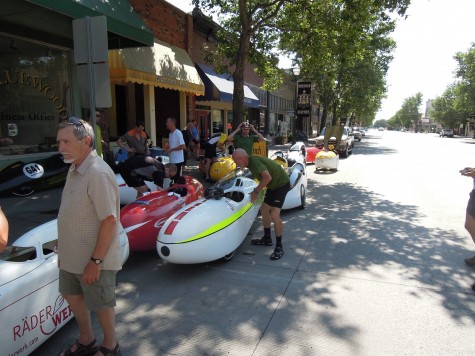
Arlington, Oregon
It was a beautiful sunny day with the temperatures in the 90s. I was feeling good, in spite of the terrible road conditions. I thought my training in the Mississippi heat would give me an edge. There was a stiff, twenty mph wind coming from the south, creating a considerable crosswind. We got back on the interstate and headed through the mountains adjacent to the Cascades, an exceptionally beautiful area in the mountains. I managed to keep near the middle of the group for a while, but the mountains had a way of separating us. The riders with electrical assist would power up the hills and scream down them! You would see them scrambling for plug-ins at the lunch stops to recharge their batteries.
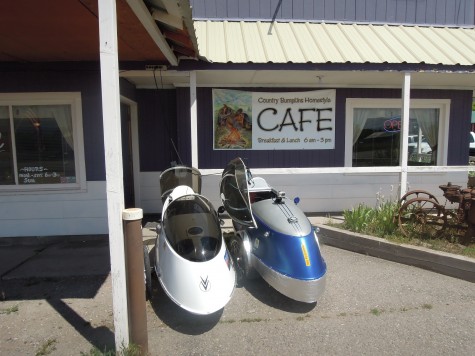
Slowly pedaling up one of the hills after lunch, I found myself all alone on the mountain and pulled over to call the shop. I asked my home team to send me the Garmin we had for sale on the floor. I knew that the routes would become more complicated as we progressed and it would be necessary to be independent and know the turns as the map was difficult to use. We would be in Missoula for a couple of days and they had a store there to send it to. I hung up the phone as three of the lightweight dutch riders caught up and passed me. They were over the hill and out of sight quickly. The surrounding mountains were gorgeous!
Coasting down the hill I had just spent an hour climbing, I saw the three Dutch Express riders cross over the huge truck rumble strips on the side of the interstate and enter the traffic lane to cross a bridge at the bottom. I could see the bridge offered no option but to deal with the considerable traffic. As they were about a half mile ahead, I thought this would be a chance to gain a bit of ground on them. Still coasting and braking, I was probably doing about twenty-five mph as I approached the bridge. Checking traffic in my mirror, I saw that the right lane was open as trucks had moved over to the left lane. I extended my left arm to signal my merger with the traffic. The velomobile has signal lights but they are often ignored by traffic, I have found.
That is when all hell broke loose. Hitting the raised rumble strips caused the steering to resist, twisting the tiller in my hand. The rear wheel went airborne over the strips and the wind blew the tail of the Mango toward the traffic. When the rear wheel touched down, it and the front left wheel dug in, causing the Mango to roll to the left, two times! My left hand got caught under the bike and my right arm dug into the rough shoulder pavement on one of the rolls. My forehead was severely gouged under my helmet visor (The helmet and visor saved the rest of my head!). When I stopped moving I was upside down looking at the guard rail with blood dripping into my eyes. I was screwed.
Being clipped in probably saved my life. My cleats held me in the bike and prevented me from being hurled into the bridge . . . or traffic. I gingerly unclipped and climbed out of the Mango. I saw the three Dutch riders about a quarter-mile ahead on the next big climb up from the bridge I was attempting to cross. They were pulled over changing another flat, I supposed. They did not know I had rolled and could not hear me because of the traffic noise and the distance. In a few minutes some more riders caught up to me and began helping out. We took a water bottle and tried to wash out the wounds. Someone suggested soap and we rubbed a hotel soap bar on the wet wounds. Don’t know if it helped or not.
The Mango had severe damage also. The top “roll bar” was crashed in, as was the nose. The Mango was now over a foot shorter! Someone suggested we knock out the nose to the original configuration right away to help retain it’s shape. OK, I said, would that work for me, too? They loaded the Mango in the last empty berth of the sag truck and me in the back seat with Stefan. Evidently, he had mechanical problems.
We were taken to the next campsite where I began to assess the damage. Showering was a mixed blessing as I had retained a significant part of I-84 in various body parts and considerable effort was required to try to extract the debris. Some duct tape from the camp store helped to hold the Mango together for a while and a visit to a drugstore in the next town secured several types of second skin spray to try to hold me together. That is amazing stuff as it gives you another chance to keep going.
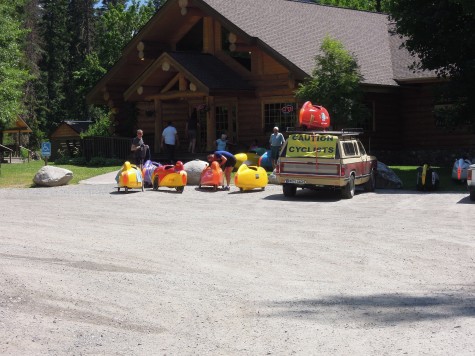
Volker's sag truck at rest stop
I had helped sag for two days. Greg had offered to let me drive his VW camping van giving him the chance to do more riding than planned. Sagging involved loading and unloading camping gear in the Mercedes Sprinter cargo van. It was amazing how much that Mercedes van held! We had gear for 45 riders, spare tires, tubes and parts to make it to DC and gear for all the support people. Everyone was very helpful to me along the way and I wanted to give back however I could. Loading and unloading was especially tough on my bloody knuckles and lifting everyone’s gear into the truck (mine was one of the heaviest!) was harder than riding! So I decided to get back in the Mango.
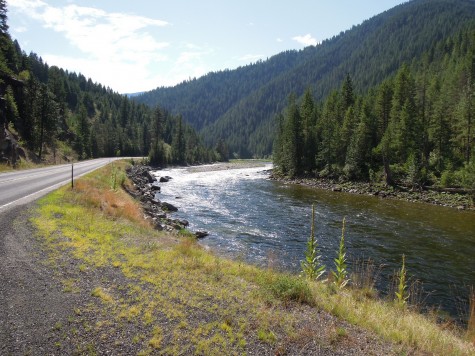
Mountain Stream
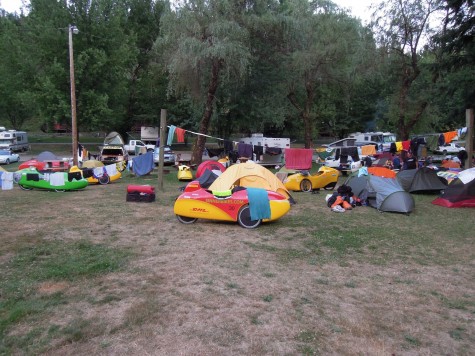
After the accident, camping took on a new dimension. One night we were in one of the lower class campgrounds and the showers were not working. I decided I needed to wash the sweat off and cleanse my wounds, so I took clean shorts, flip-flops and a towel to the mountain stream bordering the campsite. The water was very cold and the rocks were slippery. I put the flip-flop straps in my teeth and eased down in the two foot deep, fast-moving stream. Changing my pants beneath the surface of the swift stream was interesting, as there were cabins on the shore with people in them. I sat on the dirty pants to keep them from going away in the current until . . . one of the flip-flops fell out of my teeth. Panic! Must have camp shoes! I stood up and leapt head first downstream to grab the shoe. Got it, I thought . . . as I saw the pants I had been sitting on sinking out of reach. Someone will find them downstream, I guess.
Since I was riding slower than most of the group, I would make a point to leave as early as possible. This meant listening for the first tent flaps to unzip and starting my morning ritual. First, I would use the Jet Boil cup to mix up a bit of Powerbar Perform to try to pre-hydrate. Then, heating the rest of the water in the Jet Boil, I would mix in a dose of steel-cut oats and let it set for a minute or two. Adding some dehydrated blueberries and a bit of brown sugar would make a great breakfast I called “Rolling Oats”. Sometimes I would make tea also, but usually time was of the essence as many riders would have left by the time I had packed my gear and hauled it over to the sag vehicle.
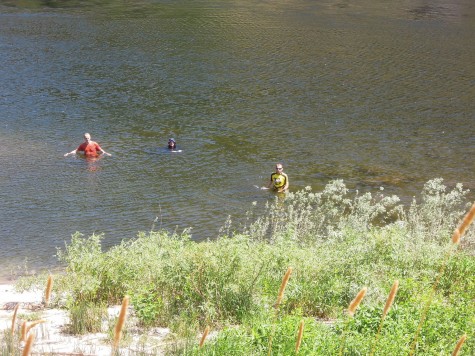
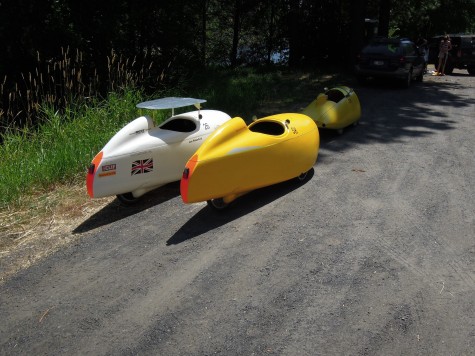
The 90 degree temperatures were beginning to wear on some. Once I saw the three British riders swimming in the river to cool off. The cool sun shade Lee had designed was coveted by many riders in the heat. Miles, Lee and Martin were together every time I saw them. It was fun to get to know them a bit and great to see the country loyalty and fellowship. I guess many of the Americans, being more diverse, took a bit more time to bond.
Some fast bikes coming down Lolo Pass!
Occasionally, I could time my departure with a small group of riders and we would stay within sight of each other for much of the day’s ride. I enjoyed riding with Harry from the Netherlands on one of these days in Montana. We had about a twenty-mile downhill out from the camp and he once exclaimed “I LOVE MONTANA!” After that exhilarating experience, we had to climb McDonald Pass. This took us about four hours of grinding in the lowest gear my Mango had . . . not quite low enough! Riders were stopping to cool their feet in the mountain stream next to the road. Harry and I shared food to keep going up the mountain. I had purchased a huge bag of fresh, green grapes the previous night. Grapes are great fuel and hydration for riding. If you are careful they won’t spill out into the nooks and crannies of the velomobile. I was not so careful, but we made it.
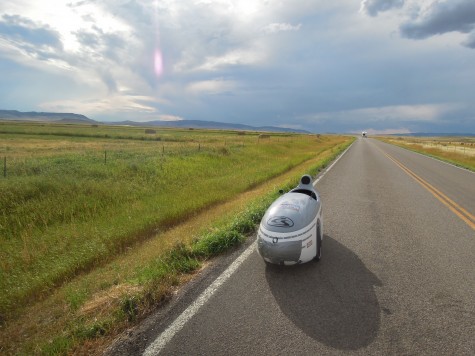
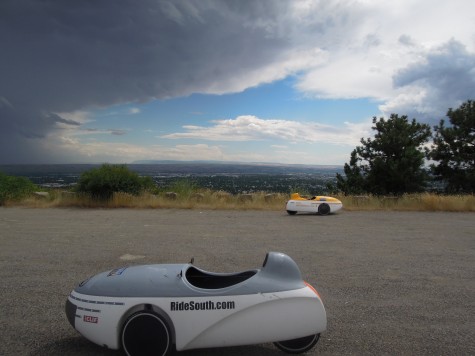
Race to beat the weather
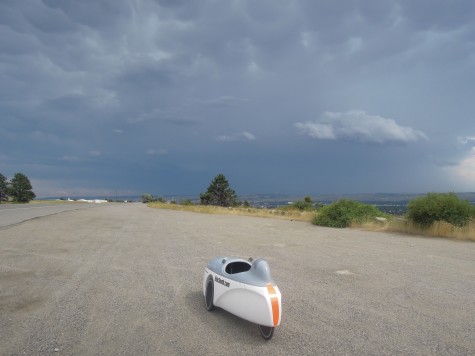
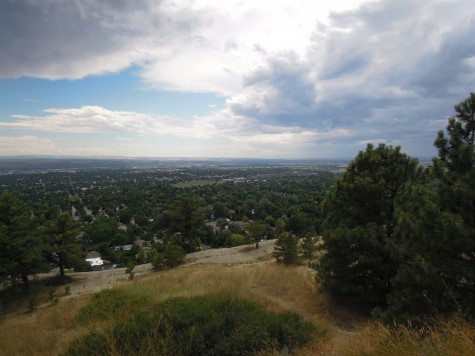
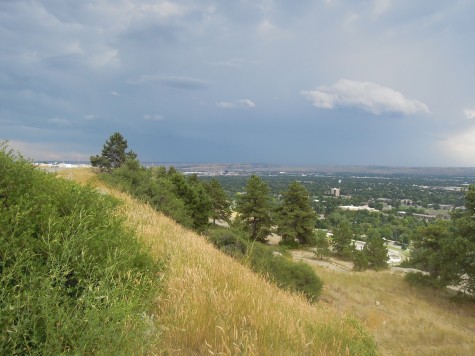
Some of the most beautiful vistas were atop the Rockies. Coming into one town, we could see a storm off in the distance. We had spent the afternoon coming down the mountain range and riding on the welcome flat. After about 30 miles of totally flat highway, we climbed again and then began a descent into town, after stopping for photos. The storm looked significant and we began a race to beat it to the campground. Navigating through city streets and back toward the west a bit, we made it to the campground before the rain hit . . . barely. I was surprised to see so many riders already in the camp until we learned they had found a short cut around town! I found a suitable patch of grass, located my gear and pitched my one person tent. Not a moment too early, as the wind and rain quickly became intense.
The rain and the bed roll were relaxing and I immediately went to sleep. I awoke feeling hungry and located the Jet Boil to heat some water for noodles. The rain was still coming down, but the tent vestibule worked as a makeshift kitchen. The “roamin noodles” were good and I was reviving a bit. Another short rest and the rain let up. Walking around the very nice campsite, I saw riders gathering for a meal being provided for us. I had evidently missed the announcement! It looked good but the noodles had filled me up. After the meal the group gathered for photos and singing happy birthday to one of the riders . . . in three different languages! Afterwards, the next day’s route was presented and riders scrambled for electrical outlets to recharge their devices, lights and velomobile batteries.
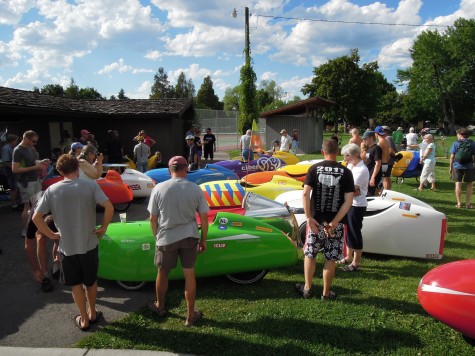
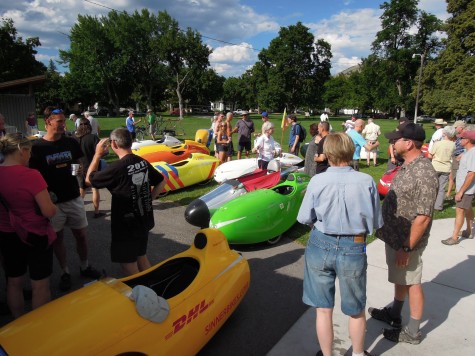
In one town, the locals put on a huge gala for us. Most of us riders helped by stopping at a grocery store on the way to the event, and picking up some food contributions. It was about ten miles from the campground, but it was on one of the few rest days so the trip was enjoyable. Of course the locals enjoyed looking at our machines and we enjoyed the break in the intense action. The rest day also gave us a chance to pedal to a local REI store to stock up on food and camping supplies. This was also the only time to perform maintenance on your machine, so the concept of “rest day” was a bit misleading. My machine was needing more care since the accident as the tape job on the front of the Mango was allowing the top of the body to sag and interfere with my pedaling. I moved my cleats up so my toes would be further down for a temporary fix. Still, the day was appreciated and enjoyable. Once, coming back from an excursion, I spotted a deer in the campground, only a few yards from our tents! The deer saw my Mango and trotted off. I guess you see all kinds of things in the mountains!
Chief Joseph Campground had to be the only place to stay when our Josef was plotting the course, or he just liked the name of the camp. It was a ball field in the outskirts of a small town in Idaho. The mosquitos were ruthless and my open wounds gave them a buffet banquet. The only good thing was a pizza place we spotted when coming into town. The real food was excellent and a couple of beers helped us to relax. We did have a visitor come into camp riding a Segway vehicle with tractor tires! She said it was a good way to get around in the mountains.
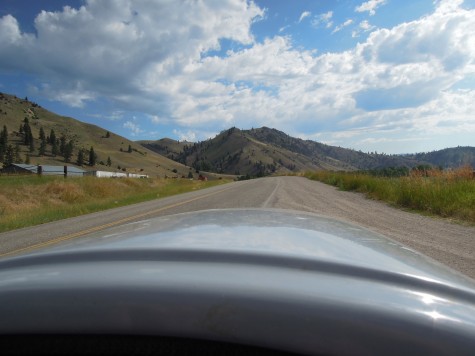
America the beautiful!
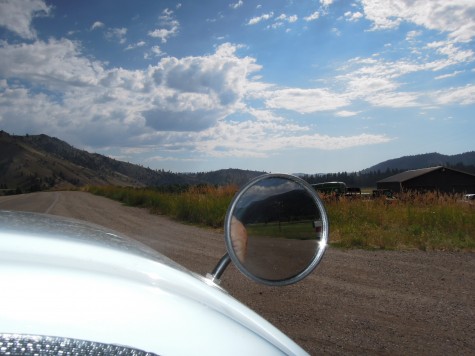
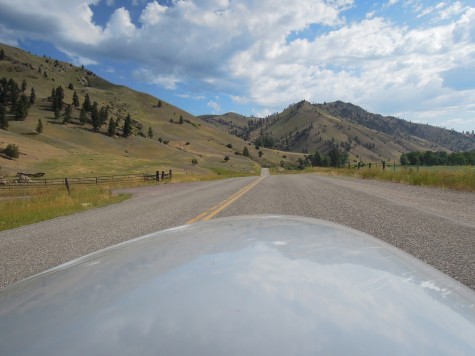
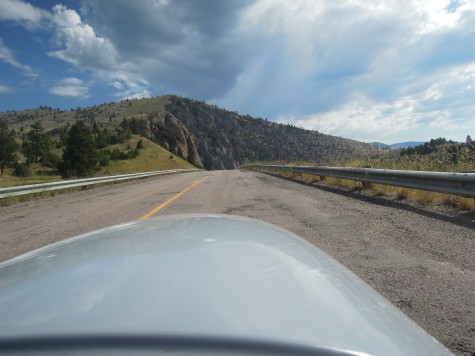
Riding all day, every day took its toll on me and the Mango. The machine was not handling very well after the crash, and I was reluctant to speed down the descents. I guess I was also a bit gun-shy and knew neither of us could withstand another crash. The sun was relentless most of the time and I took to riding with the long sleeve white shirt on that I had slept in. The shirt was impregnated with some kind of insect repellant and worked great at the camp. When riding a Mango, many riders put their arms out on climbs to help cool off. It works, but the open wounds on my right forearm began oozing and the sweat, sunscreen and insect repellant didn’t seem to make it any better. I looked a bit grotesque with bloody hands, arm and forehead. To not offend the other riders, I would look for a separate table at the lunch stops. Most of the time there were none. Either by design or, in my case, necessity, we made it to the lunch stops at different times. That worked out well for the kitchen staff as they were not used to fifty folks dropping by for lunch. Once we ate in a dark saloon that I was grateful for. The food was not that good, but the next opportunity was fifty miles away!
The riders on ROAM were a diversified group of folks. Most were European from the Netherlands, Germany, Denmark, Switzerland and England. The American riders were from California, Texas, Pennsylvania, Connecticut, Oregon, Oklahoma, Florida, Kentucky, and Mississippi. The Dutch had the largest delegation in attendance. They were called the Dutch Express. All were fit and experienced velonauts, and they mostly stayed together. One reason was that they had a support person helping to pitch camp and prepare meals for them. Yet many of them reached out to help and most were friendly and helpful in uploading routes for me and offering food and assistance when needed. The Germans, it seemed, were more on task. Josef was definitely “on a mission”. Being the organizer was a big responsibility. He was usually gone when I got up and was a strong rider. One time I was driving the VW van down Lolo Pass watching him pull away at over 70 mph! He would usually be near the front of the group and I only saw a blue quest, that looked like his machine, on the sag truck one time. It amazed me how he could keep the pace and still stop to smoke! He would also smoke in the camp at night, so I would take care to pitch my tent on the other side of the camp, if possible. That was usually not a problem since I was among the last riders in on many occasions.
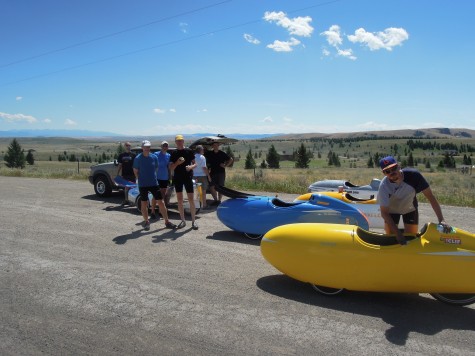
The Americans were quite friendly and excited about the adventure. Some had support teams and some were definitely loners. I could identify somewhat with one rider who kept getting lost. He was once seen backtracking and had to be fetched by the sag truck. I had taken pages from a road atlas to have a hard copy of the areas we were traversing. It turned out to be useless as routes were changed at the last-minute. Sometimes we would take a pic of the route boards and have to refer to the camera to find the lunch breaks and camps. It took several days to even get this system working. I also began to learn how to use the Garmin GPS my home team had sent to me. The best way, still, was to try to keep up with a rider who was adept with GPS and knew the way. The system Josef had planned, each rider being responsible for the rider behind making the correct turn, went away almost immediately. Another rider had to be sagged many nights due to mechanical malfunctions of his very heavy, electrical assisted machine. Josef even asked him to quit the “march” at one point, which was a little harsh I thought. Evidently, they made up and all was well in the end, I guess.
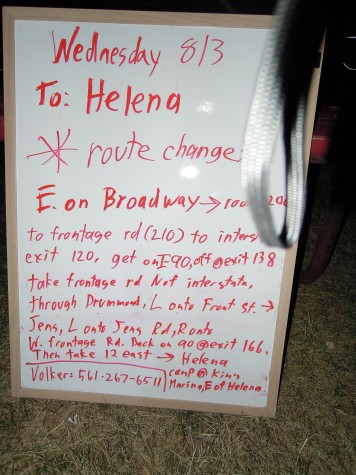
Late night route changes
The Brits also stuck close together. I got to know two of them fairly well. Miles had a shipping incident on the way to Portland and had to do some fiberglass work on his four-wheeler. He did quite well with it. Lee was a fun guy and a ball to listen to with his thick cockney accent. I got to know the other British rider quite well as he had offered a tube of antibiotic ointment for treating my wounds. Martin was in perfect shape and made me feel better when he said he was going home due to an injury. I was glad to find out he made it all the way to DC.
The heat and the fractured Mango did not get along well. Josef offered me another velomobile that Larry had been riding, as he had decided to go home early. I didn’t feel comfortable with that idea and began considering my options. Sagging the rest of the way to DC was not one of them. Every day the sag vehicles were getting more overworked and more loaded, it seemed. Velomobiles take up a considerable amount of space. My wounds were not healing well and I began worrying about infection from the lack of medical treatment. I felt needed back at the shop, even though things were in good hands. When I discovered my nephew and niece could pick me up, I decided to go home.


